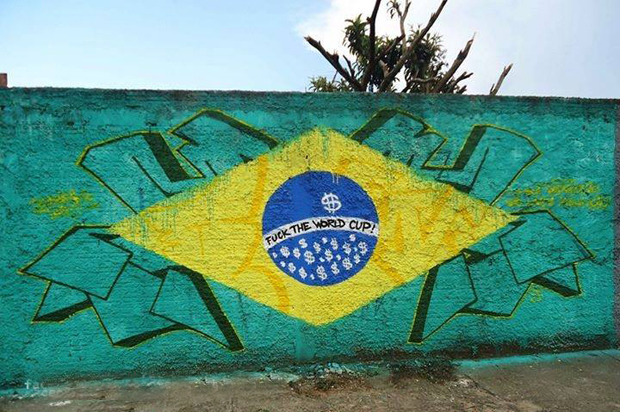
SP-Arte 2014’s opening.
Photo: Pangeia de dois/SP-Arte.
Tension and uncertainty currently engulf Brazil’s political sphere.
Eduardo Campos, the leader of the Brazilian Socialist Party (PSB) died earlier this month when the private plane on which he was traveling crashed 60 kilometers (37 miles) southeast of São Paulo. Though relatively young, at 49, Campos was seen as a shining force of innovation among Brazil’s political elite. He was one of two prime contenders set to take on Brazil’s current president, Dilma Rousseff, in elections this coming October.
The outlook for Brazil’s economy is also troubling.
Polls suggest that confidence among the country’s business leaders and consumers has entered a new trough, deeper than any since 2009. Inflation remains dangerously high at over 7 percent while growth of GDP in 2014 looks to languish at 1 percent or below. After three solid years of equally unimpressive growth, “industry has finally thrown in the towel,” Arthur Carvalho of Morgan Stanley told the Economist last week.
These troubling statistics have yet to hit the Brazilian art market. In April 2014, the third edition of the Latitude Sectorial Study—a shared effort between the Brazilian Association of Contemporary Art (ABACT), Apex-Brasil, Latitude, and Brazil’s commercial galleries—showed a trend towards further growth in the art sector, concurring with previous editions.
In particular, the Brazilian primary market for contemporary art is experiencing an extremely dynamic period: revenue continues to increase; new galleries, artists and collectors are entering the Brazilian market; and Brazil’s galleries are increasingly participating in and being recognized by the international art world to a greater degree than those from other Latin American markets.
Among international collectors surveyed, 66 percent said they had confidence in the growth of the sector over the next five years. Seventy-four percent of those polled said they intend to acquire works from the Brazilian market in the same period.
Still, a large discontinuity was observed between the strength of artistic production and the market on one side, and the fragility of Brazil’s public institutions on the other. This imbalance threatens the art system as a whole.
“Art fairs usually scatter a bit of attention from our day-to-day. I have no structure to be in many fairs and to maintain the quality of the art exhibition that is our main focus,” the owner of one of Brazil’s most prominent galleries told artnet News. Consequently, the gallery will not participate in ArtRio this year, which opens on September 10. Fair partners have also bemoaned difficulties this year, and several publications have decided to end their relationship with the fair.
Anti-FIFA art ahead of the Brazil’s World Cup
Photo: via Lunatic News
Focus is instead on the 31st Biennial of São Paulo, which opens four days earlier and is the second oldest biennial after Venice. The biennial has turned away with the market’s current obsession with singular art world darlings, instead featuring around 80 projects, each of which brings together a number of artists working in groups rather than alone. Critics are quick to point out that the last Biennial encountered serious financial and organizational challenges. Nonetheless, they remain hopeful that a focus on marginal artistic practices will breath new life into the 2014 edition.
The fervor surrounding the biennial allowed competing art fair SP-Arte to gain a bump on the calendar. April’s edition, ahead of the World Cup, was largely considered a success (see: “Samba of Sales at Opening of SP-Arte Fair“) and also launched a satellite edition of the art fair in the capital, Brasilia.
The news for Rio de Janeiro isn’t all bad, however. Nara Roesler Gallery, undoubtedly one of the most commercially aggressive dealers in Brazil and one who is working hard to take the throne from Galeria Fortes Vilaça as the country’s number one, has just announced that it will open a branch in the city.
“We do not follow market trends, but our instinct,” says Alexandre Roesler, director of the gallery. Whether others will follow remains to be seen. But, considering the roller coaster that is the Brazilian economy and the international market that has numerous gallery closures and bankruptcy of some major international titles, he very well may be right.